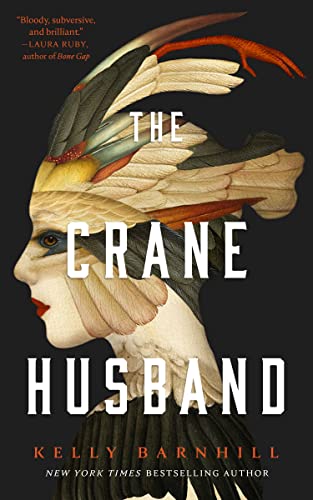Kelly Barnhill’s The Crane Husband is, in many ways a companion piece to her longer work, When Women Were Dragons. In both, the desire of a woman to break free of the normal bounds of life takes literal form, but at great cost to others. In one case, they become dragons – at times on a mass scale. The Crane Husband, based on a Japanese folktale, applies the idea of transformation to one family that has a generations-long history of women leaving their families behind by sprouting wings and flying away. At least, that’s the interpretation of the women in the family. The community has a dimmer view.
In both stories a young girl is left, though under very different circumstances, to act as the responsible adult and raise a much younger sibling. When Women Were Dragons offers a brighter side to metamorphosis, as the dragons turn out to be a loving substitute family. The Crane Husband is a somewhat darker tale, as much about abuse as the determination of a young girl to survive and become her own person. It’s also about the transformative power of art and the darkness of obsession.
The Crane Husband takes place in a near-future farming community where all the farming is done by remotely controlled drones. A distant conglomerate has bought up all the farmland to convert it into a massive factory of fields. The family of the young narrator has held onto the last farmhouse, if not the land, and ekes out a living through the mother’s fantastical tapestries and a sideline of cheese-making.
The father died when the narrator was nine and her brother Michael just an infant. But before he passed, he instructed his daughter in how to use various tools to keep the household going. And so it is that the young girl, now 15, keeps the books of account, pays the bills, handles marketing for the art work, fixes what needs fixing while her mother produces the tapestries and cheese that keep just enough money flowing in.
At least the mother does so until she comes home one day with a crane who wears a hat, spectacles and shoes with holes made by his sharp talons. She is obsessively in love with the crane, while he turns increasingly abusive. After many nights when the children hear sounds of violence from the mother’s bedroom and occasionally catch glimpses of a naked man about the house, mother and crane lock themselves into the weaving studio to work on something the mother claims is her greatest work of all.
The mother’s artwork is almost a character in itself. She stitches found objects of all sorts into telling scenes that have a strong emotional impact. As the daughter says: “My mother’s tapestries contained multitudes.”
“Her tapestries told stories inside of stories—the sweep of time and the tragedy of love and the persistent presence of the grave. Stories of lust and murder and birth, of rapacious hands clutching at scant resources, of trickster gods hiding in the leaves of dying trees … There were appliquéd women made from feathers and barbed wire, stitched onto the backing with golden thread. Babies made from buttons. Children cut from the yellowed paper of eviction notices. … She was a wonder, my mother.”.
The Crane Husband, Kindle Edition, Locations 382-388
But the daughter is not allowed to see the work she is creating now with the close attention of the crane. While the mother obsesses day after day over her new artwork and defends the crane against any hint of a problem, the situation in the house goes from bad to worse. There is little to eat, the bills can’t be paid, a social worker comes by to check on why the teenager has been skipping out of school so much, the mother eats nothing and shows up each day with more and more cuts and bruises. As the daughter watches her mother, she becomes more and more stressed.
“She thought only about the crane. And the art she made with the crane. The art that we weren’t allowed to see. The wrongness of the situation rested heavily on my shoulders. It looped around my belly and chest, winding tighter and tighter until I could barely breathe.”
The Crane Husband, Kindle edition, Locations 704-706
It’s up to the daughter to fix everything. That’s the central theme of this story as well as When Women Were Dragons. The daughter is forced to manage a household, raise a child, become the adult in so many ways. The Crane Husband is a brilliantly told story in novella length. Nothing is wasted, every scene is critical in building to the climax of the story, and the writing is filled throughout with memorable lines and insights about human nature. Kelly Barnhill has won her share of awards for children’s books, but I hope she keeps turning out such hauntingly beautiful fiction for adult readers as well.
My thanks to Tordotcom and Net Galley for an advance review copy of The Crane Husband as the basis for this review, which reflects solely my own opinions.





Leave a Reply